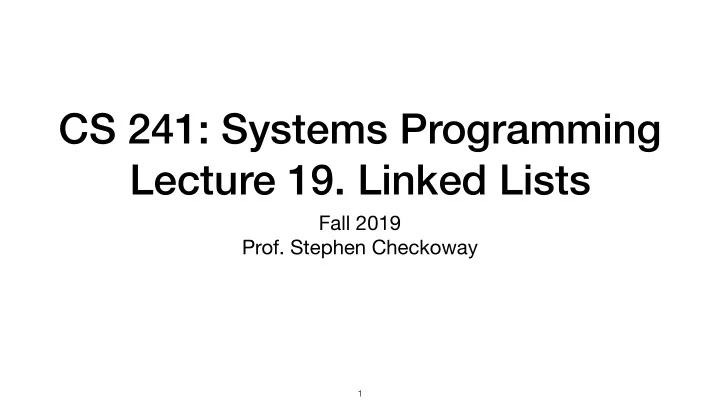

CS 241: Systems Programming Lecture 19. Linked Lists Fall 2019 Prof. Stephen Checkoway 1
Announcements Project proposal due tonight Homework 3 due tonight 2
Aside: returning multiple values In Python, functions can return multiple values (it returns a tuple) def example (): return "example", 5 In C, functions cannot; instead ‣ Return a struct struct ret_val { char const *s; int i; }; struct ret_val example1( void ) { struct ret_val r = { .s = "example", .i = 5 }; return r; } 3
Returning multiple values (cont) ‣ Add pointer parameters char const *example2( int *out) { *out = 5; return "example"; } ‣ Use global variables int example_ret; char const *example3( void ) { example_ret = 5; return "example"; } 4
Aside 2: Avoid globals Avoid global variables whenever possible Globals ‣ make your code di ffi cult to reason about ‣ make writing correct multi-threaded code extremely di ffi cult ‣ make testing individual functions di ffi cult ‣ pollute the namespace because they are available everywhere ‣ can cause implicit coupling between separate functions Sometimes globals are fine…but they're usually not what you want 5
How should a function return multiple values (in most cases) A. Return a struct B. Using pointer parameters C. Using global variables D. A or B E. A, B, or C 6
Review from Data Structures next: next: next: 0 data: data: data: A (singly) linked list is a data structure that implements the List ADT ‣ Add, insert, remove elements ‣ Ordered by position in the list Each node contains ‣ An element of the list ‣ A pointer to the next element in the list or 0 ( NULL ) for the last node 7
Review from Data Structures next: next: next: 0 data: data: data: head: tail: The list itself usually contains a pointer to the head of the list (first node) and the tail of the list (last node) 8
Data types for a list of ints typedef struct Node { struct Node *next; int data; } Node; typedef struct List { Node *head; Node *tail; } List; 9
Appending to the list next: next: 0 data: data: head: tail: 10
Appending to the list next: next: 0 next: 0 data: data: data: head: tail: 1. Create a new node with next = 0 and data set to the new element 11
Appending to the list next: next: next: 0 data: data: data: head: tail: 1. Create a new node with next = 0 and data set to the new element 2. Update tail->next to point to the new node 12
Appending to the list next: next: next: 0 data: data: data: head: tail: 1. Create a new node with next = 0 and data set to the new element 2. Update tail->next to point to the new node 3. Update tail to point to the new node 13
Appending to the list void list_append(List *list, int data) { // Create a new node. Node *node = malloc( sizeof *node); node->next = 0; node->data = data; // Update tail->next to point to the new node. list->tail->next = node; // Update tail to point to the new node. list->tail = node; } 14
void list_append(List *list, int data) { What happens if we // Create a new node. append to an empty Node *node = malloc( sizeof *node); list using this code? node->next = 0; node->data = data; // Update tail->next to point to the // new node. list->tail->next = node; // Update tail to point to the new node. list->tail = node; } A. head and tail both point to the C. tail points to the new node and new node head is 0 B. head points to the new node and D. head and tail are both 0 tail is 0 E. Undefined behavior 15
Appending the first element head: next: 0 tail: data: Set the head and tail pointers to point to the new node 16
Appending to the list void list_append(List *list, int data) { // Create a new node. Node *node = malloc( sizeof *node); node->next = 0; node->data = data; if (list_isempty(list)) { // Insert the first element in the list. list->head = node; list->tail = node; } else { // Update tail->next to point to the new node. list->tail->next = node; // Update tail to point to the new node. list->tail = node; } } 17
isempty and size // Returns true if the list is empty. bool list_isempty(List const *list) { return list->head == 0; } // Return the list size. size_t list_size(List const *list) { size_t size = 0; for (Node const *node = list->head; node; node = node->next) ++size; return size; } 18
What steps should we follow to prepend an element to the beginning of a nonempty linked list void list_prepend(List *list, int data); A. – Create a new node n containing the element – Set n->next to list->head – Set list->head to n B. – Create a new node n containing the element – Set list->head to n – Set n->next to list->head C. – Create a new node n containing the element – Set list->head to n – Set list->tail to n 19
In-class exercise https://checkoway.net/teaching/cs241/2019-fall/exercises/Lecture-19.html Grab a laptop and a partner and try to get as much of that done as you can! 20
Recommend
More recommend